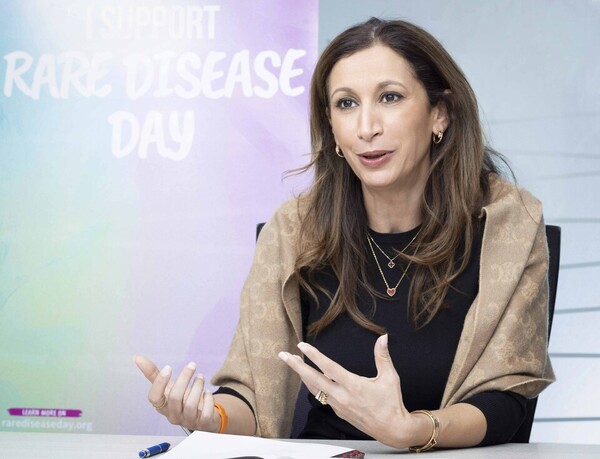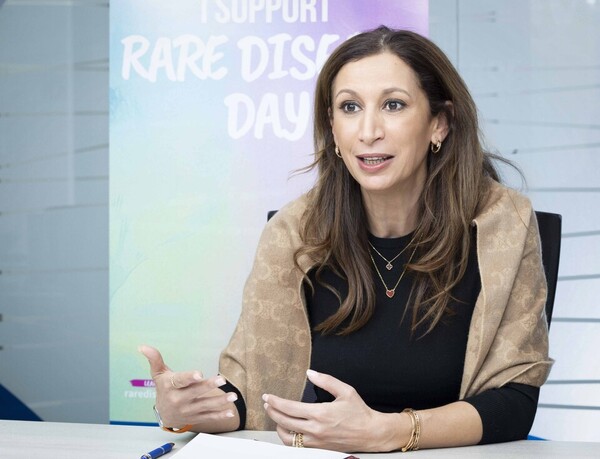With over 7,000 rare diseases worldwide—94 percent of which still have no approved treatment—one company is at the forefront of developing solutions: Ipsen. Guided by its corporate strategy, “Focus. Together. For patients and society,” Ipsen is dedicated to advancing innovative medicines in neuroscience, oncology, and rare diseases.
Ipsen, now marking its 28th anniversary in Korea, is working to accelerate the introduction of new medicines that enhance the quality of life for patients with rare and serious diseases. One such treatment is Bylvay (odevixibat 1.5 hydrate), approved in the U.S. and Europe in 2021 for progressive familial intrahepatic cholestasis (PFIC). In Korea, it was selected as the first drug under the Ministry of Health and Welfare's Parallel Pilot Project for Approval, Evaluation, and Negotiation, and received approval from the Ministry of Food and Drug Safety (MFDS) in August 2024. Now, Ipsen hopes to obtain health insurance coverage for Bylvay.
Korea Biomedical Review sat down with Leila Kockler, Senior Vice President and Head of Global Medical Affairs International at Ipsen, during her visit to Korea in February for Rare Disease Day. In the interview, Kockler shared insights into Ipsen's strategy for developing rare disease therapies and its efforts to bridge the treatment gap for these conditions.
Since 2022, Kockler has led Ipsen’s Global Medical Affairs, bringing with her extensive experience from global pharmaceutical companies such as Vertex Pharmaceuticals, Amgen, and Roche.

Leila Kockler, Senior Vice President and Head of Global Medical Affairs International at Ipsen, speaks during an interview with Korea Biomedial Review in Seoul in February. (Courtesy of Ipsen Korea)
**Question: Could you start by giving us a brief introduction to Ipsen? Additionally, could you outline the key therapeutic areas that Ipsen is currently focusing on?**
**Answer:** Ipsen is a global biopharmaceutical company founded in 1929, with its global headquarters in Paris, France, and additional headquarters in the U.K. and the U.S. With offices in 42 countries and approximately 5,000 employees worldwide, Ipsen is committed to addressing unmet medical needs. The company focuses on three key therapeutic areas: oncology, rare diseases, and neuroscience.
**Q: What is Ipsen’s strategy for developing treatments for rare diseases? Additionally, how much of the company’s total revenue comes from its rare disease therapeutics business?**
**A:** When Ipsen was founded in 1929, it focused on household and over-the-counter (OTC) medicines. However, in 2020, the company shifted its focus to specialty medicines, prioritizing three key therapeutic areas, including rare diseases. While oncology has traditionally made up a significant portion of Ipsen’s portfolio, the company has been steadily increasing its investments in rare diseases to create a more balanced pipeline.
According to its 2024 financial results released in February, Ipsen’s rare disease therapeutics segment grew by approximately 67 percent. To further expand in this area, Ipsen is actively acquiring new therapeutic assets and strengthening its presence in rare disease treatments.
**Q: What rare disease treatments are currently in Ipsen’s pipeline?**
**A:** The first area I’d like to highlight is rare liver disease. Ipsen currently has two products that are either licensed or in clinical development in this field. One of them is Bylvay, a treatment for progressive familial intrahepatic cholestasis (PFIC). PFIC is a rare genetic disorder that affects approximately 1 in 100,000 newborns, leading to severe itching and liver dysfunction due to bile acid buildup in liver cells.
In Korea, Bylvay has been approved for the treatment of pruritus in PFIC patients. In the U.S. and Europe, it has received approval not only for PFIC but also for Alagille syndrome (ALGS). The treatment is expected to play an active role in pediatric care across Asia.
Another treatment in Ipsen’s rare liver disease pipeline is Iqirvo, which is currently undergoing global clinical trials. The active ingredient, elafibranor, is being developed for patients with primary biliary cholangitis (PBC). PBC is a rare autoimmune liver disease that primarily affects middle-aged women, typically in their 40s and older. The disease causes chronic inflammation of the bile ducts in the liver, which can lead to liver fibrosis and eventual liver failure. Until now, there has been a lack of effective treatments to address the progression of the disease.
Iqirvo is a first-in-class, once-daily oral PPAR agonist that received accelerated approval from the U.S. FDA in June 2024. It has also been granted orphan drug designation by the Korean Ministry of Food and Drug Safety (MFDS). Ipsen expects elafibranor to improve patient outcomes, reduce liver damage, and delay the need for liver transplantation for as long as possible.
Ipsen holds a leadership position in the treatment of rare liver diseases, with two promising therapies currently in development. The company is also expanding its research into primary sclerosing cholangitis (PSC), a disease that is similar to PBC. In addition, Ipsen is conducting studies across five different liver diseases and sees significant potential for growth and innovation in this area.
The next disease I would like to discuss is fibrodysplasia ossificans progressiva (FOP), a rare and devastating condition that is not well understood globally and has a profound impact on patients' lives. Ipsen is developing two products for FOP: Sohonos (palovarotene) and Fidrisertib. Sohonos is already commercialized in the U.S. and Australia and is also licensed in Russia.
**Q: We understand that Bylvay will soon be available in Korea. How do you expect it to benefit patients in Korea?**
**A:** We are very pleased that Bylvay has been approved for PFIC in Korea, and we look forward to expanding access for PFIC patients soon. In Korea, the indication is for patients with PFIC over three months of age who experience pruritus. The indication varies by country, with Europe approving it for all PFIC patients, with or without ichthyosis, who are older than six months. In the U.S. and Korea, it is approved only for patients with PFIC-associated pruritus.
Bylvay is an intracellular bile acid transporter (IBAT) inhibitor specifically designed for the treatment of PFIC patients. It has received positive reviews for its ability to alleviate pruritus, a symptom that significantly impacts both patients and their caregivers. Bylvay has also been shown to reduce liver damage and delay the need for liver transplantation.
The drug is easy to take in capsule form once a day, offering patients more freedom and an improved quality of life. It also has a positive impact on caregivers, easing the burden of managing the condition.
**Q: I understand that Iqirvo is currently going through the approval process in Korea. Can you share when you expect it to be available in Korean clinics?**
**A:** First of all, Iqirvo has proven to be an effective second-line treatment for PBC in the Phase 3 ELATIVE clinical trial. This significant development enabled Ipsen to obtain approval in the U.S. and Europe. Previously, there were few effective treatments, and many available options had severe side effects. Iqirvo, however, significantly improves these aspects and has the potential to greatly enhance the quality of life and condition of patients. We believe that the introduction of Iqirvo in Korea will be of great benefit to patients.
We hope that Korea will complete the approval and reimbursement processes as swiftly as other countries, so that patients can benefit from Iqirvo as soon as possible. In the U.S., Germany, and the U.K., the drug has already been approved, and reimbursement has been granted in several European countries. The approval process is also underway in Latin America. Korea has only recently submitted an application for approval to the Ministry of Food and Drug Safety, so while we are hopeful, there is no certainty regarding the exact timeline for availability.
In addition, Iqirvo’s clinical program in Korea is ongoing. Currently, three clinical studies are either underway or in preparation, and we are optimistic about the results. Korean doctors are already using Iqirvo as a clinical trial reagent, which further supports our hope for positive outcomes.

**Q: What suggestions do you have for Korean regulators to improve patient access to treatments for rare diseases?**
**A:** The Korean regulators are experts, so I don’t dare to give advice. However, I would like to encourage pharmaceutical companies and the government to work together to provide the best possible treatment for patients, as they have a common goal. Rare diseases are not only a problem for the patient but also affect their families. Especially in the case of pediatric patients, caregivers often have to give up their livelihoods to provide care. Therefore, “speeding up” the process of reviewing treatments would be a great help to improve the lives of patients and their families.
In some countries, such as the U.S. and Germany, patients can access treatments quickly, while in others, they may have to wait three to four years. Given this disparity, it would be ideal for the government and pharmaceutical companies to collaborate in Korea to ensure that patients can benefit from treatment as quickly as possible.
**Q: In other countries, how do patient organizations contribute to the development, commercialization, and introduction of rare disease treatments, and what kind of input do they provide?**
**A:** The role and influence of patient organizations vary depending on the rare disease. In some cases, such as with cystic fibrosis, patient organizations play a strong role and can accelerate drug development. However, in the case of ultra-rare diseases, patient organizations may be smaller and less organized, making it more difficult for their voices to be fully heard. Additionally, the influence of patient organizations can differ by country and region, even for the same disease.
The most important point to emphasize is that patient organizations play a crucial role. Patients are deeply aware of their diseases and conditions, allowing them to effectively communicate their needs and situations to various stakeholders, including governments, payers, and the media, and to exert significant influence. Activating patient organizations is therefore a vital element of patient support. Ipsen is committed to listening to these organizations globally and identifying and addressing their needs as early as possible.
**Q: Finally, what message would you like to share with healthcare providers and patients in Korea?**
**A:** As a medical professional myself, I deeply understand that patients with rare diseases face incredibly difficult lives and many challenges. Their families also endure significant sacrifices and hardships, and I would like to express my deep respect for them. Most importantly, I would like to encourage patients to raise awareness of their condition and actively advocate for themselves. When patients clearly articulate their needs, responses can be made more quickly, and they have the right to assert their rights. It is crucial for patients to voice their needs, not just for their own benefit, but also to help advance the understanding and treatment of rare diseases.
I also deeply admire the research and treatment efforts of medical professionals and hope that you will continue to contribute to raising social awareness of rare diseases. Ultimately, I believe the solution to the challenges posed by rare diseases lies in the collaboration between government authorities, medical staff, patient organizations, and pharmaceutical companies. I am confident that such collaboration will create a better treatment environment, benefiting all stakeholders involved.